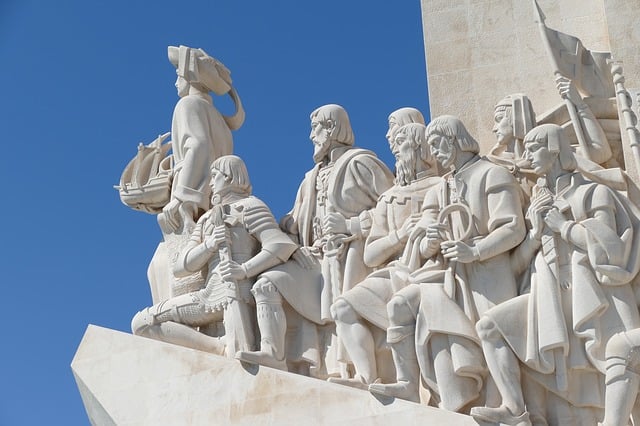Monument to the Explorers (Padrão dos Descobrimentos) is located in Lisbon’s Belém neighborhood on the northern shore of the Tagus River estuary. It was built as a tribute to the bygone era of geographic discovery of the Portuguese nation, at a time when the country was considered a thalassocracy. The site was not chosen at random, as it rises above the destination of ships returning from transoceanic voyages that were the source of the power of the Portuguese empire.
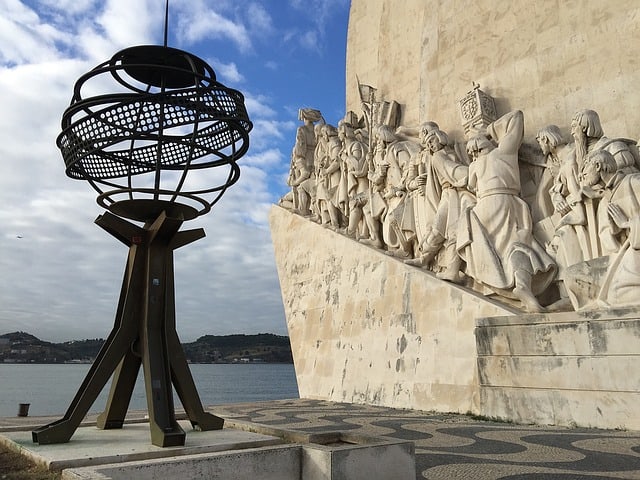
History and construction of the monument to the explorers
The monument was designed in the 1930s by Portuguese architect José Ângelo Cottinelli Telmo and sculptor Leopoldo de Almeida as a temporary beacon during the opening of the Portuguese World Exposition in June 1940. The work represented a romantic idealization of exploration, typical of the regime of New State dictator António de Oliveira Salazar. Originally built as a mere seasonal structure on the Praça do Império grounds, it was dismantled after the exposition, as no specific formalization of the investment was mentioned. Fifteen years later, the government, through the Ministry of Public Works, promoted the intention to build a permanent Monument to the Discoverers. The new monument was established with cement and rose-colored stone from Leiria, and the statues were carved from limestone quarried in the Sintra region. As part of the celebration of the fifth centenary of the death of Henry the Sailor, the opening ceremony took place.
Monuments to explorers – building
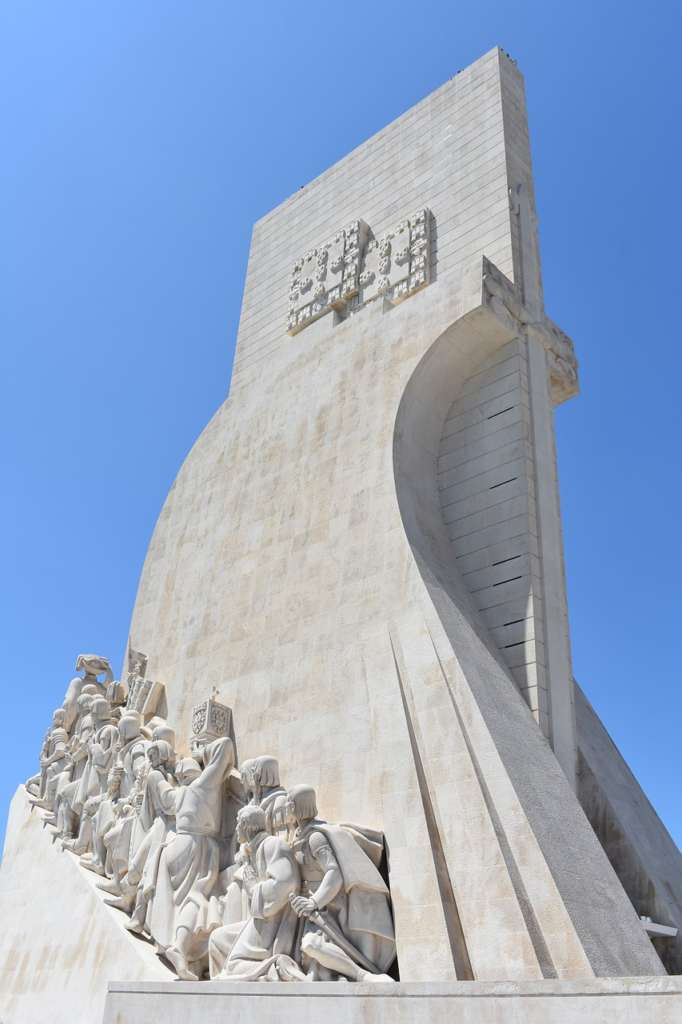
The entire design resembles a ship setting out on a distant overseas voyage. The stylized caravel appears to be setting sail into oceanic waters, with the figure of Henry the Sailor in a proud, pathetic position at the bow. On the two side ramps leading up to the symbolic figure of the prince are some of the significant figures of Portuguese territorial expansion and cultural names from the era of geographic discovery, more than thirty in all. All are depicted with symbols alluding to their identities, namely navigators, cartographers, warriors, colonizers, missionaries, chroniclers and artists.
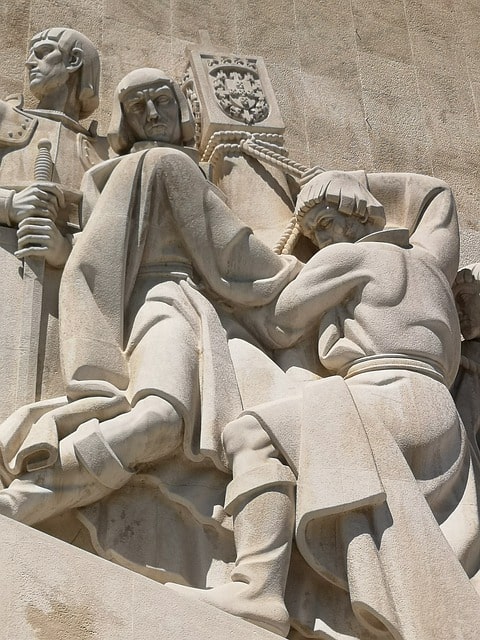
Figures of Bartolomeu Dias and Diogo Cao holding stone padrão
The images of Bartolomeu Dias and Diogo Cão carry a padrão, or stone carving, a sign of dominion in the lands being explored. Such pillars were erected wherever the Portuguese first sailed. Tourists will also notice a vertical element consisting of a stylized mast oriented north-south, with two Portuguese coats of arms on each side with five small shields, surrounded by a band with a dozen locks and a stylized heraldic lily motif in the center. From the two corners can be seen three triangular structures, each with one curved surface, giving the illusion of sails battered by the unpredictable south wind.
The northern part is formed by a pair of giant stones bearing metal letters. On the left, the inscription above the anchor reads “To the glory of Prince Henry and Portugal, charting the sea routes.” Opposite, an inscription above a laurel wreath states: “On the fifth century after the death of Prince Henry.” In the middle of the monument, nine flights of stairs give access to a platform overlooking the entire area. A second row this time of five groups of steps and a portal with an arch leads to the interior of the monument. The monument is flanked by two metal armillary spheres on two parallel-walled platforms.
Monument to the explorers – figures
Henry the Sailor – called the father of Portugal’s maritime empire. He laid the foundations for it by creating the first maritime academy in Sagres and starting the exploration of the west coast of Africa. In his hand he holds the caravel, the most famous Portuguese ship, light, maneuverable and very dangerous.
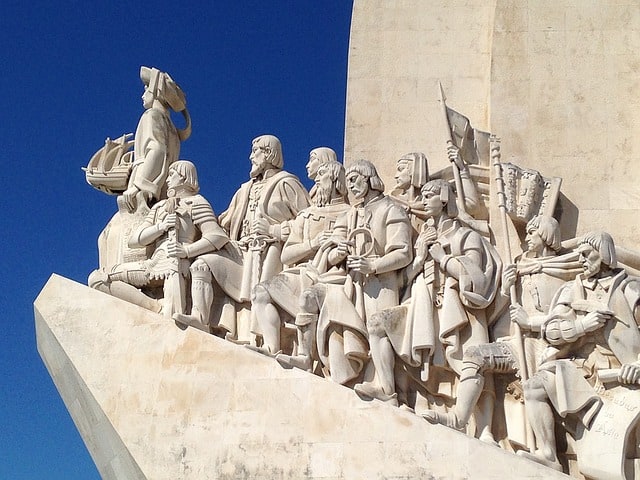
West side:
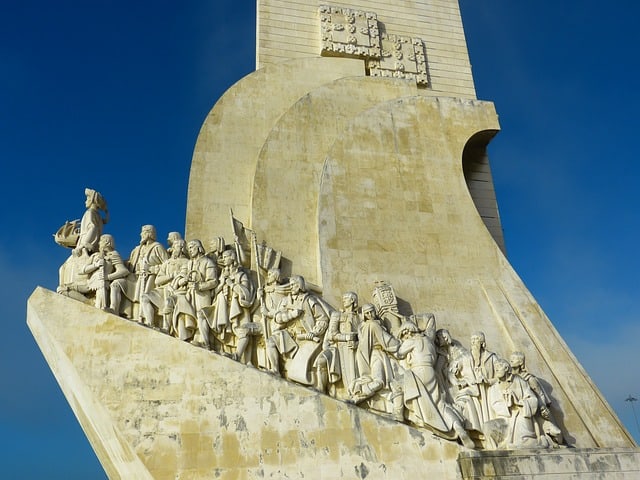
Alfonso V of Africa – his nickname refers to his conquests in northern Africa. It was thanks to him that the Portuguese conquered the Algarve – or more specifically, the part of it on the south side of Gibraltar.
Vasco da Gama – the discoverer of the sea route to India. A Portuguese who is most likely known to everyone in the world.
Afonso Baldaia – sailor, explored areas of Western Sahara on behalf of Prince Henry the Sailor.
Pedro Álvares Cabral – sailor, explorer of Brazil. He led the second expedition to India in 1500.
Ferdinand Magellan – although associated more with discoveries for the Spanish, Magellan also served for the Portuguese crown. He was the first to find his way to the Spice Islands proving the planet’s sphericity. However, he did not complete his expedition around the globe – he died in the Philippines.
Nicolau Coelho – An experienced Portuguese sailor. He took part in Vasco da Gama’s expedition en route to India, as well as Pedro Cabral’s discovery of Portugal.
Gaspar Corte-Real – sailor. Together with his father João Vaz Corte-Real and brother Miguel, he took part in many expeditions. He also sought a new route to Asia – through the Northwest Passage, over Greenland and Newfoundland.
Martim Afonso de Sousa – sailor. First governor of Brazil, and one of the governors of Portuguese India.
João de Barros – historian. He is the author of the monumental Décadas da Ásia which is a wide-ranging account of Portuguese power at sea, from its origins to Portugal’s rule over India.
Estêvão da Gama – sailor. Son of Vasco da Gama, governor of Portuguese India. He commanded a fleet that entered the Red Sea with the intention of attacking Suez.
Bartolomeu Dias – discoverer of the Cape of Good Hope. Participant in Vasco da Gama’s first expedition to India. Thanks to his information, the Portuguese discovered the possibility of circumnavigating Africa. Together with Diogo Cão they carry the padrão, a stone pillar, erected at the sites of Portuguese discoveries.
Diogo Cão – Discoverer of the Congo River, the coast of present-day Angola and Namibia.
António de Abreu – A sailor and excellent military officer. He took part in many of Afonso de Albuquerque’s expeditions, including conquering Malacca and Ormuz, and also discovered Timor and the Banda Islands in Indonesia.
Afonso de Albuquerque – Considered by many to be the most outstanding figure in the history of the Portuguese naval empire. An excellent commander, soldier and sailor. Second governor of Portuguese India. He conquered Goa, Malacca and Ormuz. His plan to build fortresses at all major points of the trade routes was a great success. He also led the first Portuguese expedition to the Red Sea.
São Francisco Xavier – missionary, co-founder of the Society of Jesus, led evangelism in India. He was the first Christian missionary to Japan, Borneo and China.
Cristóvão da Gama – Portuguese soldier and commander. He commanded Portugal’s attack on Ethiopia.
Strona wschodnia:
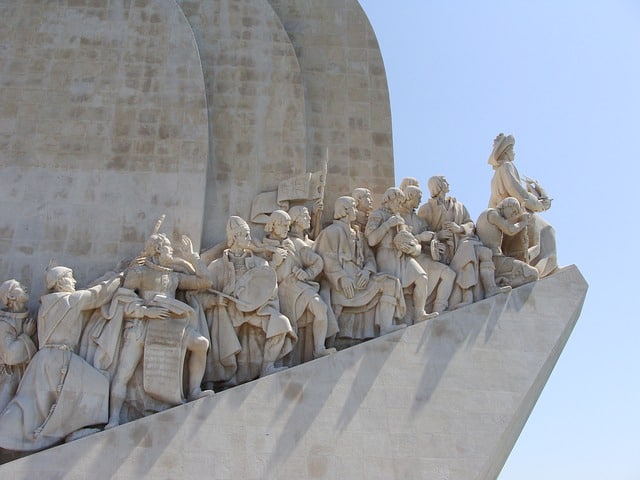
Książę Ferdynand I – Henry the Sailor’s younger brother. He took part in the siege of Tangier, during which he was captured and later died.
João Gonçalves Zarco – sailor. Together with Tristão Vaz Teixeira, he established the first settlements on Madeira.
Pêro de Alenquer – sailor. He participated in expeditions on the west coast of Africa, as well as in Bartolomeu Diaz’s discovery of the Cape of Good Hope.
Gil Eanes – sailor. He was active in the time of Henry the Sailor. He was the first to successfully circumnavigate Cape Bojador, the farthest known point in Africa in European navigation.
Pedro Nunes – Mathematician, cartographer and astronomer. He invented several measuring devices, including the vernier. In 1542 he gave the theory of rhumb lines.
Pêro de Escobar – sailor. He discovered the islands of São Tomé. Annobon and Principe. He also took part in Vasco da Gama’s expedition to India and Pedro Cabral’s discovery of Brazil. Escobar also holds the flag of the Order of Christ in his hand.
Jacomo de Maiorca – cartographer.
Pêro da Covilhã – merchant, spy. His overland expedition explored the trade route between India and Arabia. He also ended up in Ethiopia and confirmed the existence of “King John” (John the Presbyter), the legendary Christian king of Africa.
Gomes Eanes de Zurara – chronicler. He wrote down information about the siege of Celta led by Henry the Sailor, as well as the conquest of Guinea.
Nuno Gonçalves – Painter at the court of King Alfonso V of Africa. Considered the author of the Saint Vincent panels depicting Portuguese society in the 15th century.
Luiz de Camões – Considered the most outstanding Portuguese poet, often called the Portuguese Homer. Author of the Lusiadas (Os Lusiadas), a Portuguese national epic recounting Vasco da Gama’s expedition to India.
Henrique de Coimbra – Franciscan missionary. He participated in Cabral’s discovery of Brazil and celebrated the first Mass there.
Gonçalo de Carvalho – Dominican missionary. He created Catholic communities in India, as well as in the Congo.
Fernão Mendes Pinto – writer and sailor. He wrote Peregrinação, an autobiographical memoir about his travels, according to historians not very accurate and a bit colorful. This earned him the nickname Fernão Mentes Minto (a play on words with the Portuguese verb mentir – Fernão, are you lying? I am lying).
Królowa Filipa Lancester – Wife of King John I, mother of Henry the Sailor. The only female figure on the monument, she is buried in a monastery in Batalha.
Książę Piotr – Brother of Henry the Sailor, Duke of Coimbra. In Portugal, he is best known as Prince Pedro of the “seven parts of the world” because of his love of travel.
Taras widokowy
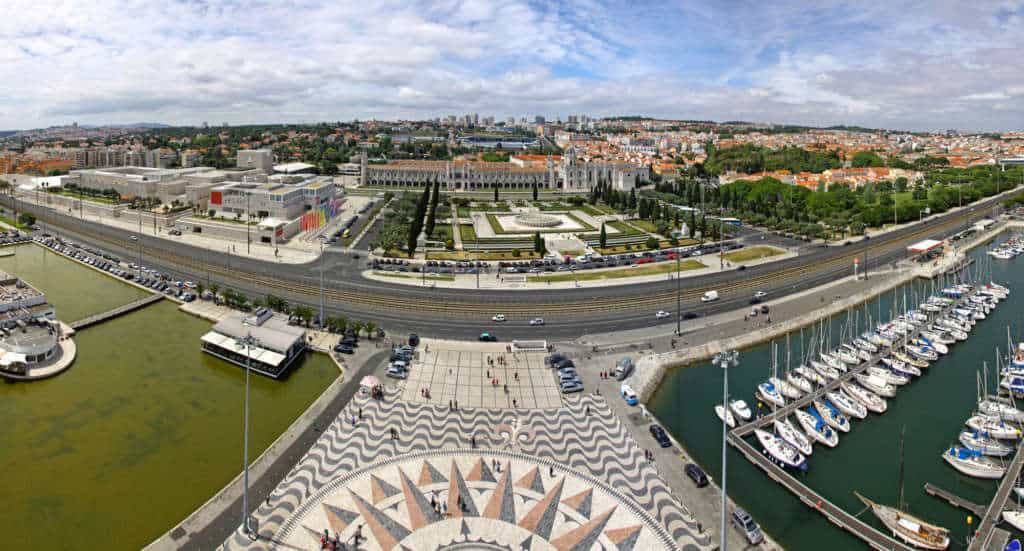
From the huge observation deck you can enjoy a stunning panorama of the buildings of Belem, the estuary of the Tagus River into the Atlantic, as well as a mosaic depicting the rose of the winds, a map of the world and the roads by which the Portuguese made their expeditions. The compass artwork adorns the plaza in front of the Monument to the Discoverers. It was made thanks to black and red lioz limestone from exceptional deposits in Sintra. It has a diameter of 50 meters and includes a planisphere 14 meters wide decorated with plant elements. The finishing touches include small compasses of five, three inflatable faces personifying the wind, mermaids, mythical fish, Neptune with a trident and trumpet riding a sea beast. Dates, ships, caravels mark the main routes of Portuguese expansion in the 15th and 16th centuries. The background consists of waves of the open sea, a motif commonly used for typical Lisbon sidewalks.
Observation deck – ticket prices
Normal ticket – 6 euros
Reduced ticket (from 13 to 18 years old) – 3 euros
Senior ticket (over 65 years old) – 5 euros
Lisboa Card: 4,80 euro.
The ticket includes admission to the observation deck, a temporary exhibition (generally about tourism) and a screening of a film about the construction of the Monument to the Explorers (daily at 3:30 pm, lasts about 50 minutes and has English subtitles).
